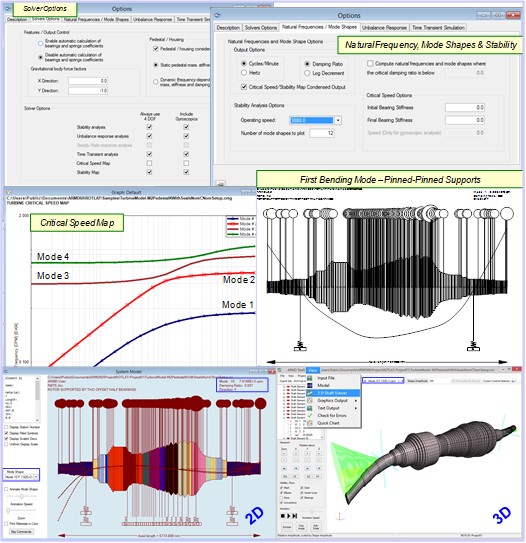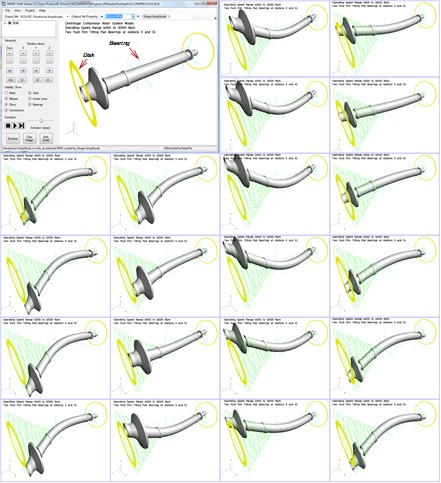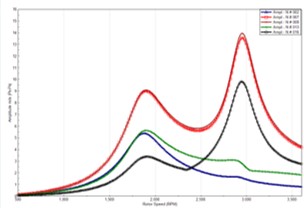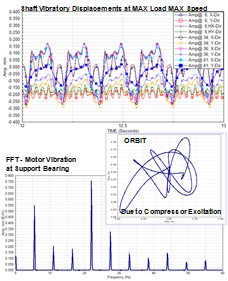
The rotor dynamics package “ROTLAT V6.2” uses a finite-element based formulation for performing damped and undamped lateral natural frequencies, mode shapes, stability, unbalance response, and time-transient response of rotating systems. ROTLAT has its own user interface and integrates four modules: ROSTAB, ROTORMAP, ROSYNC, and RORESP. The user interface controls the modules to provide a complete lateral vibration analysis environment.
ROTLAT permits user selectable output units between CPM or Hz, in accordance with the user’s preference, or the industry standard format, which can be set simply by checking a box in the options form. Also damping parameter (ratio or log. dec.) can be selected. Full user control for generating critical speed maps with or without speed or gyroscopic effects are provided. Additionally, forces (excitations) such as unbalance considered in synchronous response analysis can be combined with gravitational body forces and any externally applied forces and moments in the time transient response simulations.

ROTLAT results include:
NATURAL FREQUENCY, MODE SHAPE, AND STABILITY
(Modules “ROSTAB”+ “ROTORMAP”)

UNBALANCE RESPONSE
(Module “ROSYNC”)

TIME-TRANSIENT RESPONSE
(Module “RORESP”)

Figures and screenshots provided with kind permission of RBTS.
Current version V6.2 of the complete ARMD package (PDF): ARMD-V6.2
Package: ROTLAT (Rotor Dynamics)
Download (PDF): ROTLAT-V6.2
Our next Vibration Seminar is planned again for 2024. We will inform you in time about the contents, the exact date and registration possibilities.
Click here to go straight to our latest WEBINARS for engineers:
Free Webinars: HIGHLY RELEVANT
We would like to offer our best custom-tailored engineering service concerning your current project. Please send us your inquiry (submission of your inquiry).
Do you already know our new HELP AREA (Support - Questions & Answers)?
This link will take you there immediately:
| Cookie | Description |
|---|---|
| Necessary / Notwendig | |
| CookieLawInfoConsent | CookieYes sets this cookie to record the default button state of the corresponding category and the status of CCPA. It works only in coordination with the primary cookie. |
| cookielawinfo-checkbox-analytics | Set by the GDPR Cookie Consent plugin, this cookie records the user consent for the cookies in the "Analytics" category. |
| cookielawinfo-checkbox-performance | Set by the GDPR Cookie Consent plugin, this cookie stores the user consent for cookies in the category "Performance". |
| viewed_cookie_policy | The cookie is set by the GDPR Cookie Consent plugin and is used to store whether or not user has consented to the use of cookies. It does not store any personal data. |
| cookielawinfo-checkbox-necessary | This cookie is set by GDPR Cookie Consent plugin. The cookies is used to store the user consent for the cookies in the category "Necessary". |
| cookielawinfo-checkbox-non-necessary | This cookie is set by GDPR Cookie Consent plugin. The cookies is used to store the user consent for the cookies in the category "Non Necessary". |
| Non Necessary / Nicht notwendig | |
| test_cookie | This cookie is set by doubleclick.net. The purpose of the cookie is to determine if the users' browser supports cookies. |
| Analytics / Analytik | |
| _ga_* | Google Analytics sets this cookie to store and count page views. |
| _ga | This cookie is installed by Google Analytics. The cookie is used to calculate visitor, session, camapign data and keep track of site usage for the site's analytics report. The cookies store information anonymously and assigns a randoly generated number to identify unique visitors. |
| _gid | This cookie is installed by Google Analytics. The cookie is used to store information of how visitors use a website and helps in creating an analytics report of how the wbsite is doing. The data collected including the number visitors, the source where they have come from, and the pages viisted in an anonymous form. |
| Performance / Leistung | |
| _gat | This cookies is installed by Google Universal Analytics to throttle the request rate to limit the colllection of data on high traffic sites. |
Phone: +49 2204 84-2630 • Fax: +49 2204 84-2639 • Email: info@laschet.com • Web: www.laschet.com
HOME – ABOUT US – ENGINEERING – WEBINARS – SEMINARS – TECHNICAL CONSULTING – CONTACT
Site Notice – Privacy Policy – Information Obligation – Cookie Manager – Legal Notices


